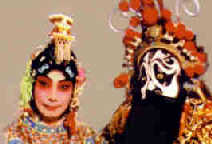 With its fascinating and artistic accompanying music, singing and costumes, the Peking Opera is China's national opera. Full of Chinese cultural facts, the opera presents the audience with an encyclopedia of Chinese culture, as well as unfolding stories, beautiful paintings, exquisite costumes, graceful gestures and martial arts. Since Peking Opera enjoys a higher reputation than other local operas, almost every province in China has more than one Peking Opera troupes. Opera is so popular among Chinese people, especially seniors, that even "Peking Opera Month" has been declared.
With its fascinating and artistic accompanying music, singing and costumes, the Peking Opera is China's national opera. Full of Chinese cultural facts, the opera presents the audience with an encyclopedia of Chinese culture, as well as unfolding stories, beautiful paintings, exquisite costumes, graceful gestures and martial arts. Since Peking Opera enjoys a higher reputation than other local operas, almost every province in China has more than one Peking Opera troupes. Opera is so popular among Chinese people, especially seniors, that even "Peking Opera Month" has been declared.
 Development
Development
Peking Opera has a 200-year-long history. Its main melodies originated from Xipi and Erhuang in Anhui and Hubei respectively and, over time, techniques from many other local operas were incorporated.
It is believed that Peking Opera gradually came into being after 1790 when the famous four Anhui opera troupes came to Beijing. Peking Opera underwent fast development during the reign of Emperor Qianlong and the notorious Empress Dowager Cixi under the imperial patron, eventually becoming more accessible to the common people.
From the 1920's to the 1940's of last century was the second flourishing period of Peking Opera. The symbol of this period was the emergence of lots of sects of the opera. The four most famous were "Mei" (Mei Lanfang1884-1961), "Shang" (Shang Xiaoyun 1900-1976), "Cheng" (Cheng Yanqiu 1904-1958), and "Xun" (Xun Huisheng 1900-1968). Every sect had its groups of actors and actresses. Furthermore, they were extremely active on the stage in Beijing,Shanghai, and so on. The art of Beijing Opera was very popular at that time.
After the reform and opening-up policy, Beijing Opera had new development. Especially as the traditional quintessence of China, Beijing Opera got great support from the government. Today, the Beijing Chang'an Opera House holds international competitions every year that attract many people from various countries. Beijing Opera is also the reserved program for the communication between Chinese and many foreign cultures.
 Performance
Performance
In ancient times, Peking Opera was performed mostly on stage in the open air, teahouses or temple courtyards. Since the orchestra played loudly, the performers developed a piercing style of song that could be heard by everyone. The costumes were a garish collection of sharply contrasting colors to stand out on the dim stage illuminated only by oil lamps. Peking Opera is a harmonious combination of the Grand Opera, ballet and acrobatics, consisting of dance, dialogue, monologues, martial arts and mime.
The Peking Opera band mainly consists of an orchestra and percussion band. The former frequently accompanies peaceful scenes while the latter provides the right atmosphere for battle scenes. The commonly used percussion instruments include castanets, drums, bells and cymbals. One person usually plays the castanets and drum simultaneously, which conduct the entire band. The orchestral instruments include the Erhu, Huqin, Yueqin, Sheng (reed pipe), Pipa (lute) and other instruments. The band usually sits on the left side of the stage.
 Facial Painting
Facial Painting
It is said that this special art derived from Chinese opera has different origins. But no matter what its origin, facial painting is worth appreciating for its artistic value. The paintings are representations of the characters' roles. For example, a red face usually depicts heroic bravery, uprightness and loyalty; a white face symbolizes a sinister, treacherous and guile character and a green face connotes surly stubbornness, impetuosity and lack of self-restraint. In addition, facial painting patterns reveal information about a character, as well. Essentially, the unique makeup allows characters on stage to reveal them voicelessly.
